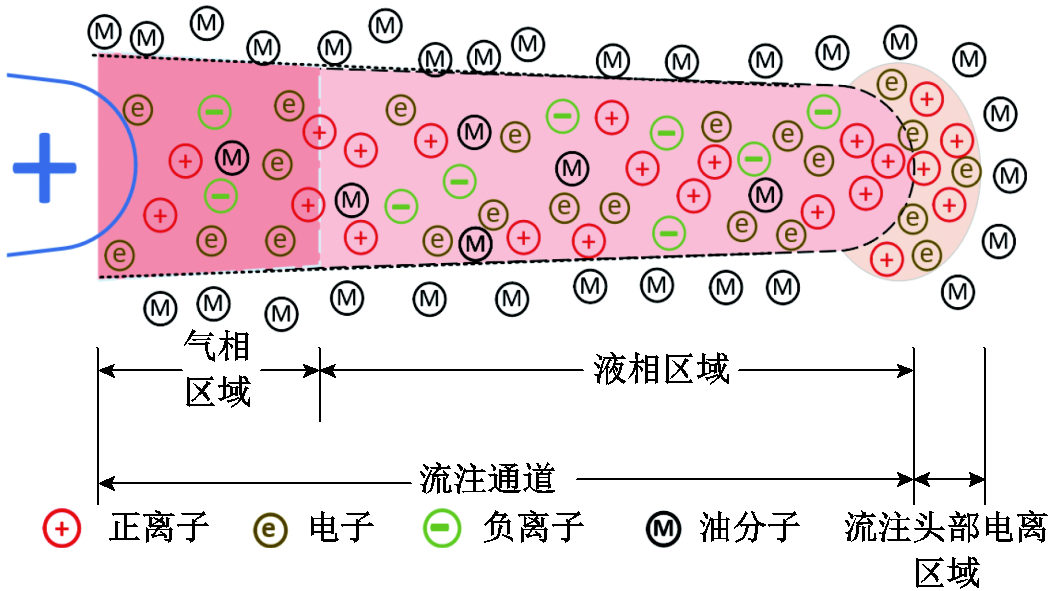
图1 流注结构示意图
Fig.1 Schematic diagram of streamer structure
摘要 流注放电是一个非常复杂的多尺度、多物理场耦合过程,目前尚无准确的模型能描述其发展过程。相变及光电离是影响流注演变的重要因素,但现有流注放电模型很少将其影响考虑到模型内。为分析二者对流注放电的影响,该文在COMSOL中建立针/板放电几何模型,以酯基绝缘油为研究对象,基于电流体动力学模型,以相变温度为临界点,分别构建气相和液相下的电离机制。此外,建立了与电场阈值相关的光电离数学模型。结果表明,光电离的引入促使优势流注分支的产生,且光电离主要发生在优势流注头部区域。由于高温区域主要集中在针尖处,气相区域会随着局部温度的升高而产生,在电场作用下,气相区域发生碰撞电离,在针尖处产生更多的小流注分支。气相区域对主流注的传播速度几乎没有影响,主流注的传播速度主要受场致电离和光电离的控制。光电离在流注头部产生了更多的载流子,促使改进模型的主流注以更快的速度传播,从而易实现传播模式从慢速到快速的转换。该文可为酯基绝缘油快速流注的产生机理提供新的研究思路,为提高其击穿电压提供指导依据。
关键词:酯基绝缘油 光电离 气相 流注放电
随着我国特高压输电技术的不断进步,变压器的电压等级不断提高,绝缘问题也变得越来越突出。绝缘油作为油浸式变压器重要的组成部分之一,在变压器的安全运行中扮演着关键的角色[1-3]。酯基绝缘油具有高燃点、易降解、能延长变压器寿命等优点[4-10],在绿色低碳发展的大环境下,酯基绝缘油取代矿物油的趋势也被越来越多的研究者认可和接受[11-13]。
目前,基于酯基绝缘油的流注放电特性研究主要集中在试验观察,O. Lesaint根据流注的平均传播速度将流注的传播划分为四种传播模式[14],即第一模式(速度约为0.1 km/s)、第二模式(速度约为 2 km/s)、第三模式(速度约为10 km/s)和第四模式(速度大于100 km/s)。其中,第一模式和第二模式为慢速流注,第三模式和第四模式为快速流注。然而与矿物油相比,酯基绝缘油在放电过程中易产生快速流注,进而导致其在极不均匀电场下的击穿电压偏低[15]。为了获得抑制酯基绝缘油快速流注产生的方法和机理,有必要对酯基绝缘油在冲击电压下流注放电的微观物理过程展开研究。但目前的试验仅能得到放电过程中物理现象的宏观特征,而无法深入了解详细的微观物理过程。因此需要借助数值模拟方法,探究酯基绝缘油流注放电的微观机理。
近年来,许多学者采用电流体动力学模型研究液体电介质放电的微观过程。美国麻省理工学院的J. G. Hwang等通过耦合电流连续方程和泊松方程,仿真获得了冲击电压下矿物绝缘油的单流注模型[16-17]。李元和王哲明等进一步探究了不同放电参数(电压幅值、上升沿和油隙距离)和不同电介质(环己烷和天然酯)的流注放电过程[18-19]。施健和汪沨等在变压器油中添加了纳米粒子、金属离子和悬浮粒子,探究了其对流注传播的影响[20-21]。然而,上述流注放电模型均基于场致电离理论,通常假定电离仅在液相中发生,而忽略了气相中的电离过程。试验研究表明,在放电过程中有气相区域的产生,其中,放电产生的焦耳热被认为是气相形成的重要原因[22-24]。由于气相和液相内的载流子迁移率和介电常数存在极大差异,因此,有必要研究气相过程对流注放电的影响。
此外,快速流注的产生伴随着强烈的光信号,施加电压越大、流注传播越快,产生的光照越强,一些学者认为流注放电中存在光电离[17, 25-27],并认为其是流注速度从第二模式转换到第三模式甚至第四模式的关键机制。梁苏宁和李向荣等研究了紫外吸收剂对酯基绝缘油雷电击穿特性的影响[25-26]。结果表明,紫外吸收剂的加入提高了酯基绝缘油的加速电压和击穿电压,抑制了流注传播速度,间接地证明了光电离的存在。建立光电离模型需要多个参数,如光强、光电离截面和吸收系数等,由于这些参数极难测量,目前很少有学者对液体电介质中光电离的数学模型进行研究。因此,需要对光电离进行一定程度的简化建模以探究光电离对流注放电过程的影响机理。
本文以先前制备的一种合成酯绝缘油——三羟甲基丙烷酯(Trimethylolpropane Ester, TME)为研究对象[28],基于电流体动力学模型,以相变温度为临界点,分别构建了气相和液相下的电离机制。此外,构建了与电场阈值相关的光电离模型,在COMSOL中建立了酯基绝缘油针/板电极下的流注放电模型,对比研究了改进前后模型的流注形态变化、不同时刻下流注通道内的温度分布、流注传播特性以及空间电荷分布特性。本文可为研究酯基绝缘油流注放电的微观过程提供新的研究方法和思路。
在流注传播过程中,电离主要发生在流注通道的尖端并产生正离子和电子。在正极性电压的作用下,由于迁移率和极性的不同,电子以比正离子更快的速度向针尖移动。在电子的移动过程中,一些电子也可能与中性分子吸附形成负离子。正流注通道中正电荷和负电荷的分离在流注头部形成了正空间电荷区,进一步增强了电场并推动电场峰值向前移动。因此,在模拟中电场峰值的移动代表了流注通道尖端的传播。流注结构示意图如图1所示。在电场作用下,电荷的移动会产生焦耳热,进而促使局部液体温度升高,随着热量逐渐积累,在该区域发生相变形成气相区域,而靠近这一区域的流注通道仍处于液相状态[29-30]。研究发现,液相区域中正离子和电子的迁移率分别约为10-9 m2/(V∙s)和10-4 m2/(V∙s)[17],而在气相中两者的迁移率分别高达10-4 m2/(V∙s)和10-1 m2/(V∙s)[31]。除此之外,气相和液相区域的介电常数也相差较大。因此,需要分别对气相区域和液相区域的电离机制建模。

图1 流注结构示意图
Fig.1 Schematic diagram of streamer structure
由于液体电介质流注放电过程涉及多个物理过程,建立完整的物理模型极度困难,虽然本文考虑了放电过程中的相变及光电离过程,但不得不对这两个过程进行相应的简化。因此在相变建模过程中忽略了气相与液相间的相互作用、气相中的压力和密度变化,以及气相中带电粒子与液相之间的相互作用等;在光电离建模过程中忽略了分子的光电离相关参数、放电产生的光强分布等物理过程。这其中的每一个物理过程的详细描述均具有挑战性[24]。
基于齐纳理论的场致电离被认为是液体电介质中载流子产生的主要方式[20, 32-33]。场致电离是一种纯电场驱动的电离机制,在强电场作用下,液体电介质的分子获得足够高的能量而发生电离。该机制已广泛用于不同液体电介质的流注放电模型中,如绝缘油[17-21, 34-35]、水[36]和超临界氮[37]。场致电离项可表示为
 (1)
(1)
式中,e为单位元电荷;ni为分子数密度;a为分子间距;m*为分子质量;E为电场强度;h为普朗克常数; 为液相分子电离能。
为液相分子电离能。
碰撞电离是气体放电过程中载流子产生的主要机制之一,尤其是在较高的电场强度下[38]。通过使用单位阶跃函数H(T)定义碰撞电离源项是否作用,表示为
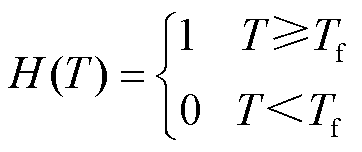 (2)
(2)
式中,T为实时油温;Tf为TME油的相变温度。TME油的相变温度Tf约为500 K,当实时油温T<Tf时,H(T)=0,表示无气相区域产生,碰撞电离源项不作用;反之,当实时油温T≥Tf时,H(T)=1,表示有气相区域产生,碰撞电离源项作用。基于第一汤森系数[39](如式(3)所示)的碰撞电离源项[17]如式(4)所示。
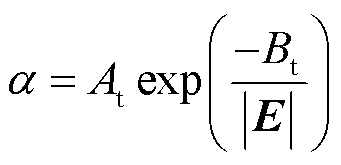 (3)
(3)
 (4)
(4)
式中,At为指数前系数,与气体分子间的自由程有关,取At =2.0×108 m-1[17];Bt为电子从基态被激发到第一激发态所需的电场强度[39],取Bt=3.0×109 V/m[17];ρe_g为气相电子密度;μe_g为气相电子迁移率。
与场致电离和碰撞电离不同,光电离是一种辐射引起的电离机制。建立液体电介质中的光电离模型需要确定多个参数,由于这些参数极难测量,导致液体电介质中的光电离模型难以建立,因此,需要对光电离项进行简化建模。
在外加电场下,由于斯塔克效应(Stark Effect),分子电离能 会随着外加电场的增加而减小,表达式为[40]
会随着外加电场的增加而减小,表达式为[40]
 (5)
(5)
式中,Δ为零电场下的分子电离能;γ为电离能参数。当电离能降低到一定程度时,放电过程产生的光子的能量可能足以激发绝缘油分子内的电子进而发生光电离[41]。因此,可认为光电离强度与分子电离能呈负相关,即
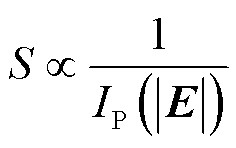 (6)
(6)
式中,S为光电离项。
流注放电是一个高能释放过程,会导致放电区域的温度骤升。李向荣等利用流注图像数值解析方法估算了流注放电过程中的温度分布,发现最高温度约1 000 K[42]。温度的升高为绝缘油分子电离提供了部分辐射能量,可能导致分子更易发生光电离,因此可认为光电离强度与温度呈正相关,即
 (7)
(7)
O. Lesaint测量出了冲击电压下环己烷中的光强,发现35 kV电压下的第三模式快速流注的光强是14 kV电压下的第二模式慢速流注的4倍左右[14]。这种观察结果表明,快速流注的传播相较于慢速流注具有更强的光信号。基于上述研究,施加的电压等级越高(即电场强度越大),观察到的光信号往往越明显,这可能是因为在较大电场强度下,光电离的发生会更加显著,即
 (8)
(8)
因此可以认为,当电场强度超过某个阈值时才考虑光电离过程。为此,引入阶跃函数 和阈值电场强度
和阈值电场强度 ,认为当实时电场强度
,认为当实时电场强度 ≥
≥ 时,发生光电离;反之,当实时电场强度
时,发生光电离;反之,当实时电场强度 <
< 时,忽略光电离项,即
时,忽略光电离项,即
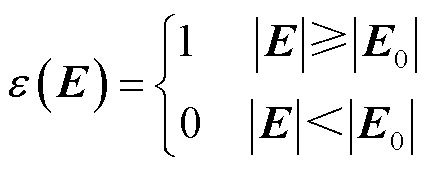 (9)
(9)
对光电离进行精准建模难度较大,在建模过程中主要依据现有参数,如模拟中的电场强度、温度和分子电离能对光电离进行简化建模。观察场致电离项(式(1))和碰撞电离项(式(4))的数学表达式,发现这两个公式均可写为式(10)的形式。因此,依据该形式对光电离进行建模,并进行相应的无量纲化以获得光电离项,见式(11)。
 (10)
(10)
式中,K1为指数前系数;K2为指数项系数。
 (11)
(11)
式中,A为电场强度 =
= 时的光电离初始值,其数值通常取1×1010~1×1014 m-3[17,43],本文中取A=1×1012 m-3;n为指数,用来调节光电离项随电场强度变化的速率,为了体现高电场(电场强度大于2.5×108 V/m)对光电离率的影响,取n=3;c为调节系数,用于调节分子电离能和温度对光电离的影响程度,取c=-1。
时的光电离初始值,其数值通常取1×1010~1×1014 m-3[17,43],本文中取A=1×1012 m-3;n为指数,用来调节光电离项随电场强度变化的速率,为了体现高电场(电场强度大于2.5×108 V/m)对光电离率的影响,取n=3;c为调节系数,用于调节分子电离能和温度对光电离的影响程度,取c=-1。
将式(5)代入式(11)可得到
 (12)
(12)
其中,已有模型中流注放电的电场强度 范围在1×108~4×108 V/m之间[16, 32, 34-35],取其中间值,令
范围在1×108~4×108 V/m之间[16, 32, 34-35],取其中间值,令 =2.5×108 V/m。
=2.5×108 V/m。
此外,光电离发生的随机性与空间电场分布有直接关系,即仿真几何区域中每一个点发生光电离的概率都依赖局部电场强度大小,电场强度越大,光电离发生的概率越高。为此,通过构造光电离概率密度函数P,以计算空间上光电离发生的可能性,其表达式[44]为
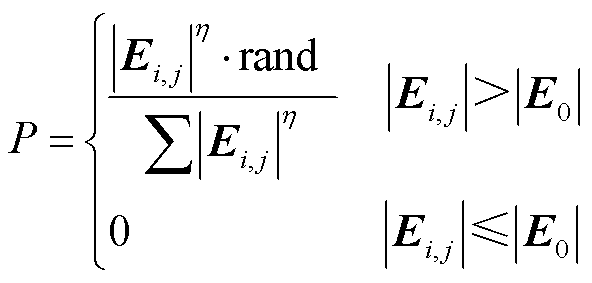 (13)
(13)
式中, 为光电离待发生点(i, j)处的电场强度;rand为仿真软件中的随机函数;η为发生光电离的概率指数;
为光电离待发生点(i, j)处的电场强度;rand为仿真软件中的随机函数;η为发生光电离的概率指数; 表示在η值控制下全部可能发生光电离点的电场强度的总和。
表示在η值控制下全部可能发生光电离点的电场强度的总和。
本文采用电荷连续方程(式(14)~式(16))与泊松方程(式(17))描述载流子的产生、复合、运动以及空间电场变化过程。通过传热方程(式(18))计算油温的变化。
 (14)
(14)
 (15)
(15)
 (16)
(16)
 (17)
(17)
 (18)
(18)
 (19)
(19)
式中,ρn、ρe_l和ρp分别为液相负离子、电子和正离子密度; 、
、 和
和 分别为液相负离子、电子和正离子迁移率;
分别为液相负离子、电子和正离子迁移率; 为正、负离子复合率;
为正、负离子复合率; 为正离子、电子复合率;τa为电子吸附时间;εr和ε0分别为绝缘油相对介电常数和真空介电常数;ρoil为绝缘油密度;kT为导热系数;
为正离子、电子复合率;τa为电子吸附时间;εr和ε0分别为绝缘油相对介电常数和真空介电常数;ρoil为绝缘油密度;kT为导热系数; 为绝缘油流速,由于流注放电时间短,速度可忽略不计;
为绝缘油流速,由于流注放电时间短,速度可忽略不计; 为绝缘油比热容;J为电流密度。仿真所涉及的参数及取值见表1。
为绝缘油比热容;J为电流密度。仿真所涉及的参数及取值见表1。
表1 主要参数[18, 45-47]
Tab.1 Main parameters[18, 45-47]
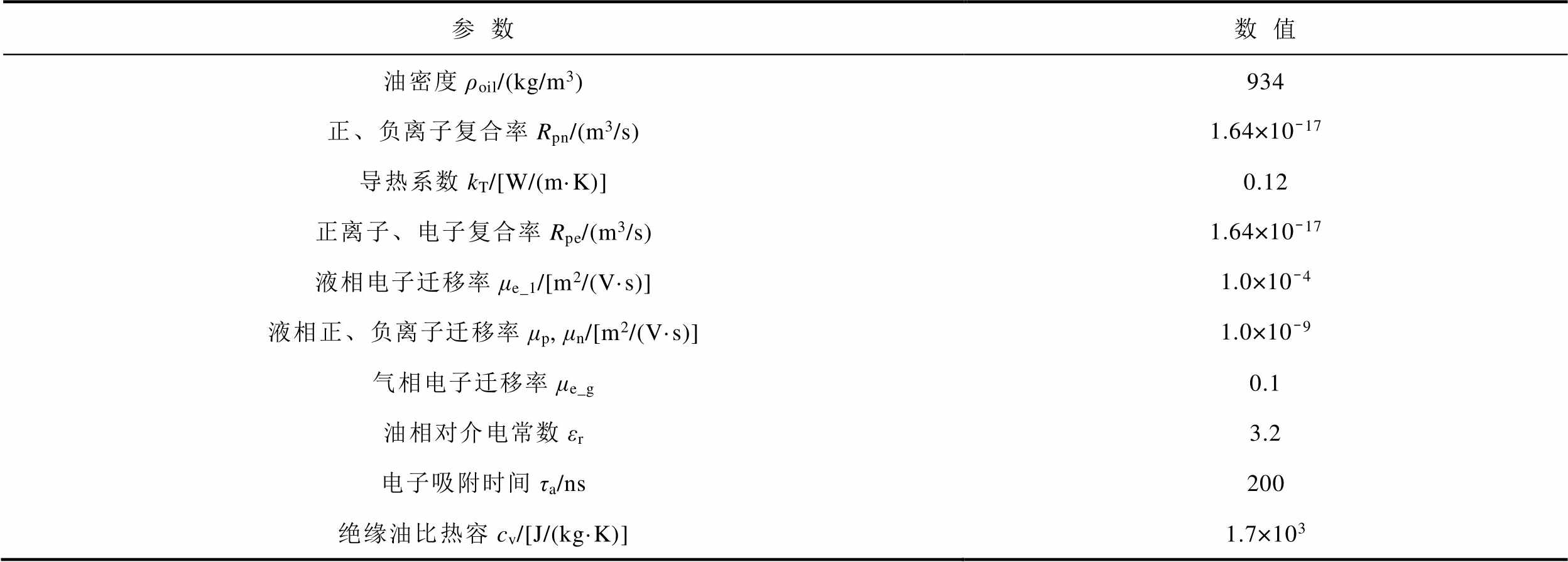
参数数值 油密度ρoil/(kg/m3)934 正、负离子复合率Rpn/(m3/s)1.64×10-17 导热系数kT/[W/(m·K)]0.12 正离子、电子复合率Rpe/(m3/s)1.64×10-17 液相电子迁移率μe_1/[m2/(V·s)]1.0×10-4 液相正、负离子迁移率μp, μn/[m2/(V·s)]1.0×10-9 气相电子迁移率μe_g0.1 油相对介电常数εr3.2 电子吸附时间τa/ns200 绝缘油比热容cv/[J/(kg·K)]1.7×103
施加电压的波形用双指数函数表示为
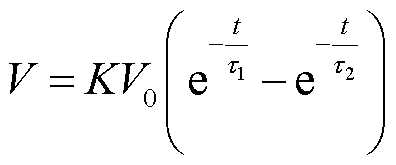 (20)
(20)
式中,K为电压调节系数;V0为施加电压;τ1和τ2分别为波头时间和波尾时间,用于调节电压上升沿时间,τ1=31 ns,τ2=600 ns。
目前,受测试手段的限制,试验所拍摄的流注多为二维图像[15, 48],因此大部分模拟仅从二维角度进行研究[34, 41]。在本文试验中,测试绝缘油的流注放电过程采用的是针/板电极几何结构,其结构具有轴对称性,出于对可行性和计算效率的考虑,在COMSOL中建立了二维轴对称针/板电极模型[17-18, 32],如图2所示。
构成针电极的材料为铜,其曲率半径为50 μm,油隙为5 mm。整个模拟区域的尺寸约为r×z= 15 mm×13 mm。边界A-B-C定义为高压电极,边界D-E-F定义为板电极,H-G为油边界。边界条件设置见表2。
其中,光电离项的引入方式为:在COMSOL中建立与电场和温度相关的光电离函数表达式(式(12)),将光电离项作为一个新的电离项,与场致电离项和碰撞电离项共同构成该模型的带电粒子产生机制,当满足光电离触发条件时,光电离才会发生,进而影响流注放电过程。
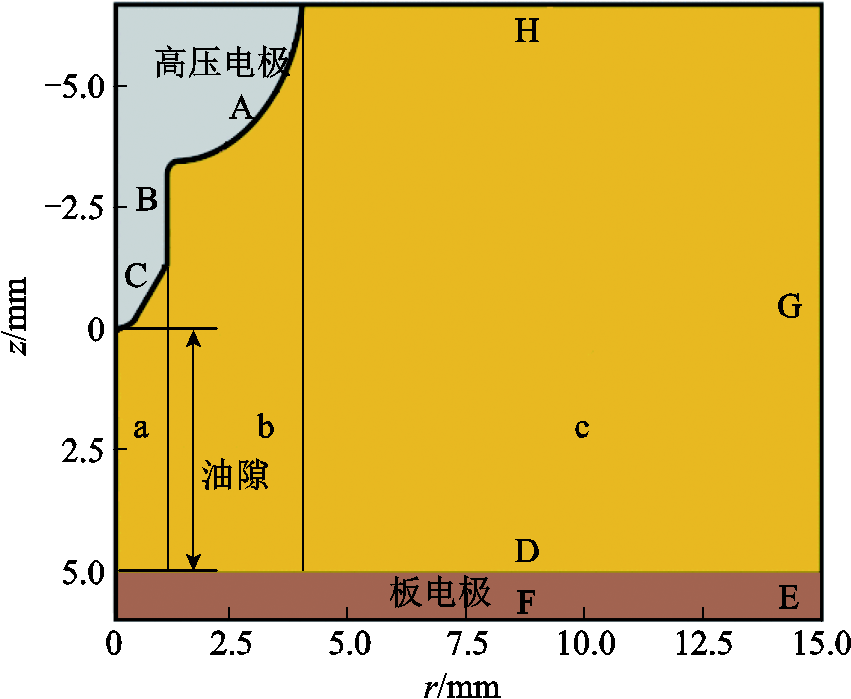
图2 几何结构
Fig.2 Geometric structure
表2 边界条件
Tab.2 Boundary conditions

控制方程高压电极板电极油边界对称轴 电流连续方程有通量有通量无通量不适用 泊松方程电势接地零电荷不适用 传热方程热绝缘热绝缘热绝缘不适用
由于流注放电主要发生在对称轴附近区域[18],为了优化计算能力并节省模拟时间,将模拟区域划分为a、b、c三个区域(见图2),a区域的网格设置为极细化,并进行细化处理,网格大小从a区域向外依次增加。为了避免数值求解过程中出现局部振荡并使模型更好地收敛,求解器选择PARDISO,并添加人工扩散项[18]。
为了探究相变和光电离项对酯基绝缘油流注放电过程的影响,将改进模型和原始模型计算的流注形态进行对比,如图3所示。图中,电场云图分布状态代表流注形态,电场强度峰值的移动代表流注的发展。由于流注主要在高压电极附近的mm尺度范围内产生并传播,因此,图3展示的为该区域的局部放大图。在电压幅值为100 kV、上升沿时间为50 ns的冲击电压下,原始模型仅计算得到一个单流注放电过程,随着时间的增加,流注仅沿着对称轴(z轴)发展。其中,高电场强度区域主要分布在流注的头部和边缘处,头部的电场强度最大。
与原始模型不同,改进模型在30 ns时不仅有沿着对称轴方向的主流注,还有更多的流注分支产生。随着时间的推移,这些流注分支逐步发展成优势流注分支。在45 ns和60 ns时刻,针尖处产生了更多的小流注分支。改进模型的整体流注形态特征与试验观察结果更接近,试验观察结果如图4所示。此外,改进模型中优势流注通道半径比原始模型中的要小,这可能是由于流注分支数量的增加削弱了单个流注通道中的能量[15]。

图3 100 kV上升沿50 ns冲击电压下流注形态对比
Fig.3 Comparison of streamer morphology under lightning impulse voltage of 50 ns on the rising edge of 100 kV

图4 TME绝缘油在冲击电压下的流注发展过程
Fig.4 Streamer process of TME insulating oil under lightning impulse voltage
为探究这些优势流注分支产生的原因,分析了轴线上的温度约分布,如图5所示。在30 ns时刻,油隙内的最高温度约为450 K,低于相变温度Tf,不满足碰撞电离发生条件,但在30 ns时刻,其最大电场强度Emax=2.6×108 V/m,满足光电离发生条件,当流注的局部电场强度数值大小超过发生光电离的阈值电场强度之后,光电离项产生的大量载流子会导致局部电场发生畸变,促使流注分支的产生,因此这些优势流注分支的产生是由光电离项导致。此外,由式(12)可知,光电离率的大小与电场强度密切相关,电场强度幅值越大光电离率越高。30 ns和55 ns时刻的光电离发生区域如图6所示,在30 ns和50 ns时刻,光电离发生的区域主要集中在优势流注分支头部。
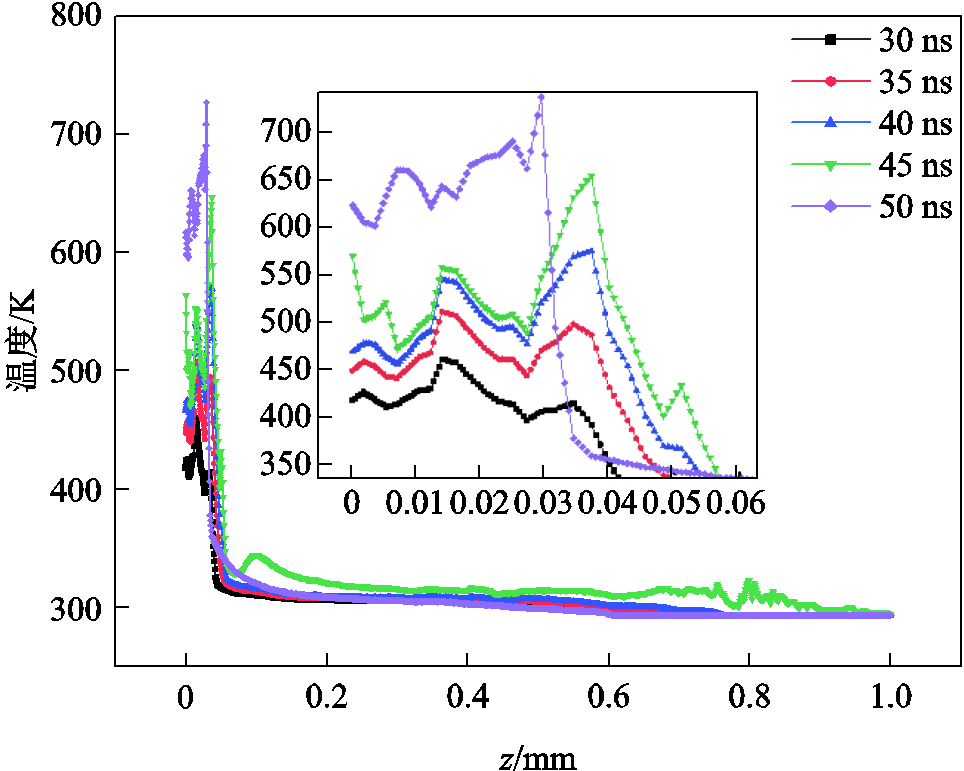
图5 油隙内温度分布
Fig.5 Temperature distribution in oil gap
为进一步分析相变过程对流注放电的影响,对比了有无相变过程下的流注形态特征,如图7所示。可发现除了针尖处的小流注分支形态不同外,其他流注形态上两者均比较相近,再次证明了小流注分支的产生是由相变过程引起的。同样地,大量试验结果证明,增加静压力能抑制放电过程中小流注分支的产生[49-51],这可能是由于静压力的增加使得气相区域较难产生,从而抑制了小流注分支的产生。
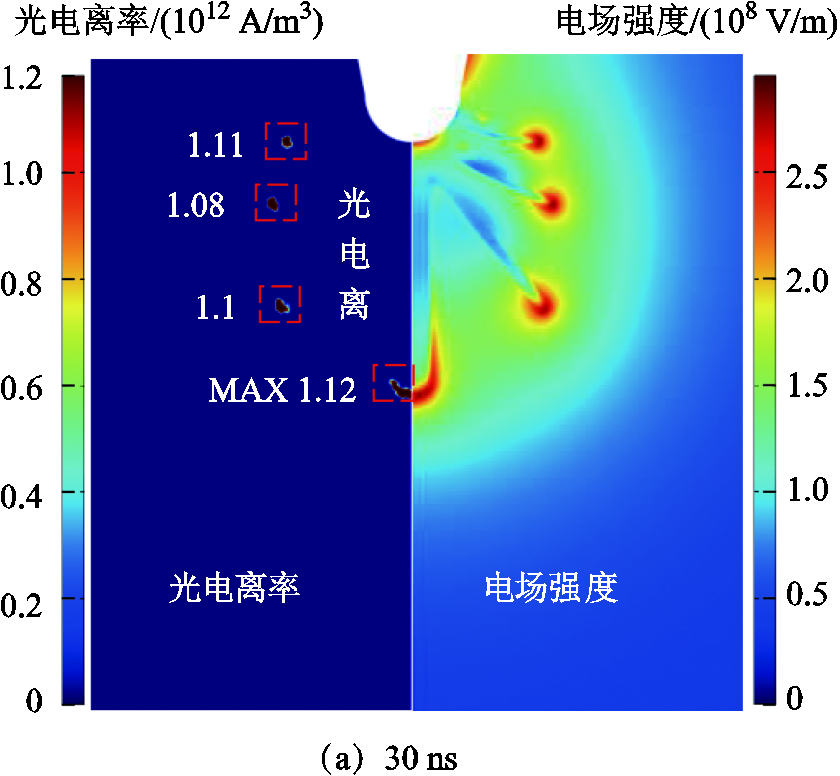

图6 30 ns和55 ns时刻的光电离发生区域
Fig.6 Photoionization region at 30 ns and 55 ns

图7 无相变模型和改进模型的流注形态对比
Fig.7 Comparison of streamer morphology between non phase transition model and improved model
从图7中可知,同一时刻下有无相变过程的主流注速度差异较小,因此,相变过程对主流注的发展速度影响很小,这主要是由于其发展过程是由光电离和场致电离控制。无相变模型和改进模型的主流注速度对比如图8所示,可见随着外施电压的增加,光电离和场致电离的作用被加强,两者之间的主流注速度差异进一步减小。E. M. Hizal 和D. Linhjell等发现通过施加静压力可有效地减少流注分支的产生,但对流注的发展速度几乎没有影响[49-51],这与本文的模拟结果相吻合。
流注速度与液体电介质的击穿电压紧密相关,由于酯基绝缘油在冲击电压下易产生快速流注而导致其击穿电压偏低,因此有必要对比分析改进前后的模型对流注速度的计算效果,结果如图9所示。对比不同电压下主流注的传播速度可发现,改进模型和原始模型的流注速度变化趋势相近,即先增加到一个最大值然后逐步降低,这与试验观察到的现象相符[52]。
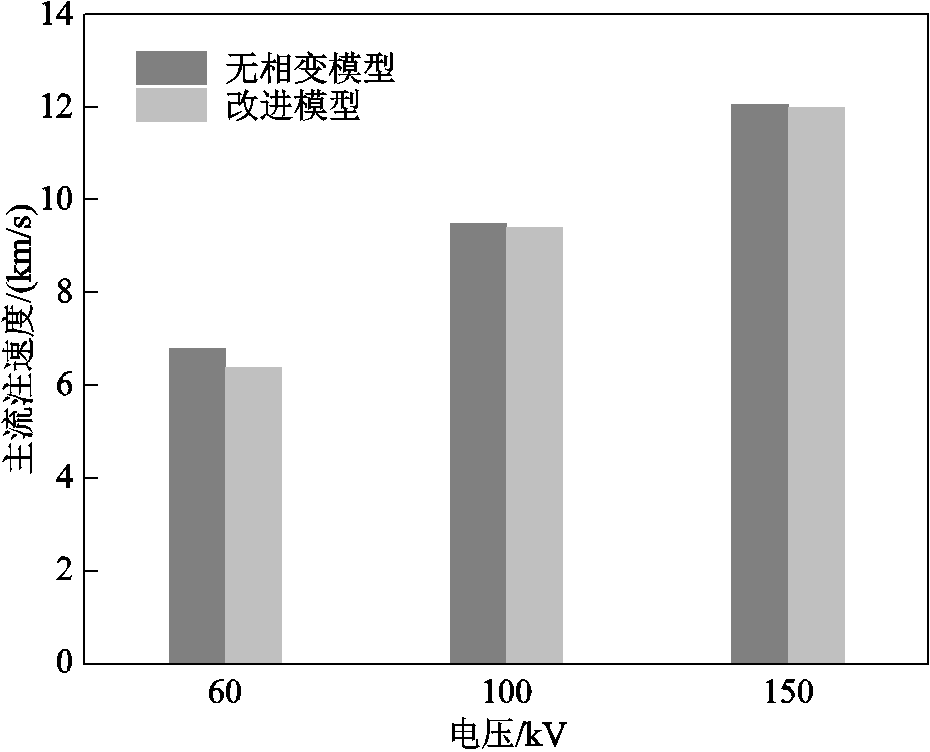
图8 无相变模型和改进模型的主流注速度对比
Fig.8 Comparison of main streamer velocity between non phase transition model and improved model
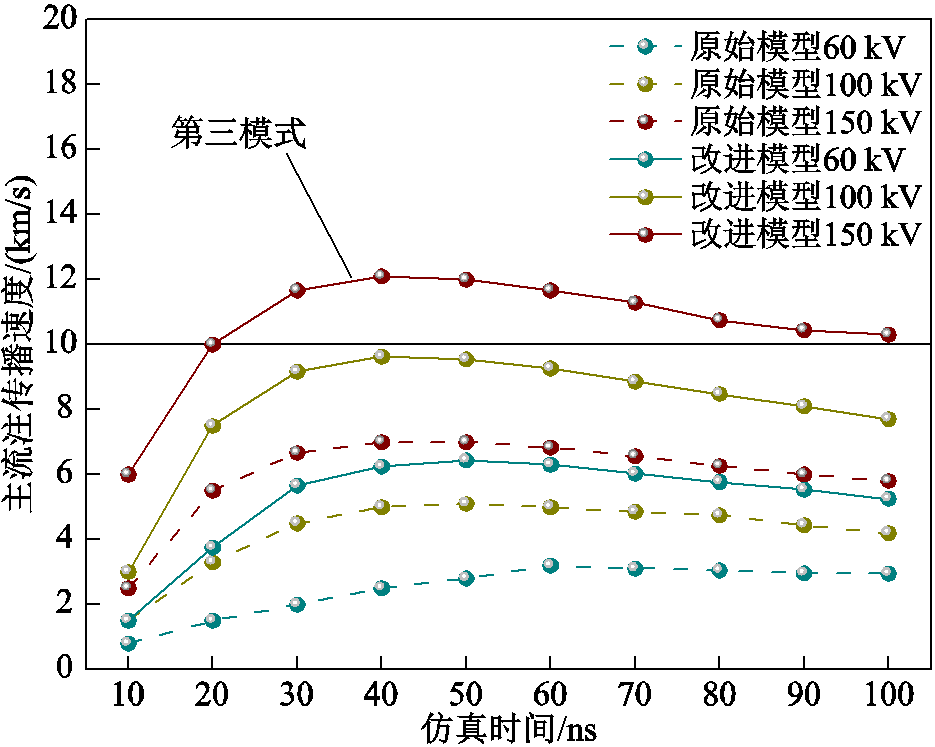
图9 主流注传播速度
Fig.9 Main streamer propagation velocity
然而,相同电压和时刻下原始模型的流注传播速度均为第二模式,且都小于改进模型的流注传播速度。改进模型在60 kV和100 kV的电压下的速度均在第二模式范围内,但在150 kV电压下,改进模型的流注速度率先实现了从第二模式到第三模式的转换。造成这种现象的原因是在150 kV电压40 ns时,其流注头部的电场强度峰值高达3.55×108 V/m,其光电离率约为60 kV和100 kV电压下的2.5倍和2.0倍,如图10所示。光电离率越高,载流子产生速率越快,数量越多,越利于流注的快速传播。综上所述,原模型并不能很好地反映酯基绝缘油中快速流注产生的过程,而基于光电离和相变过程的改进模型能更好地模拟在较高电压等级下快速流注的产生。
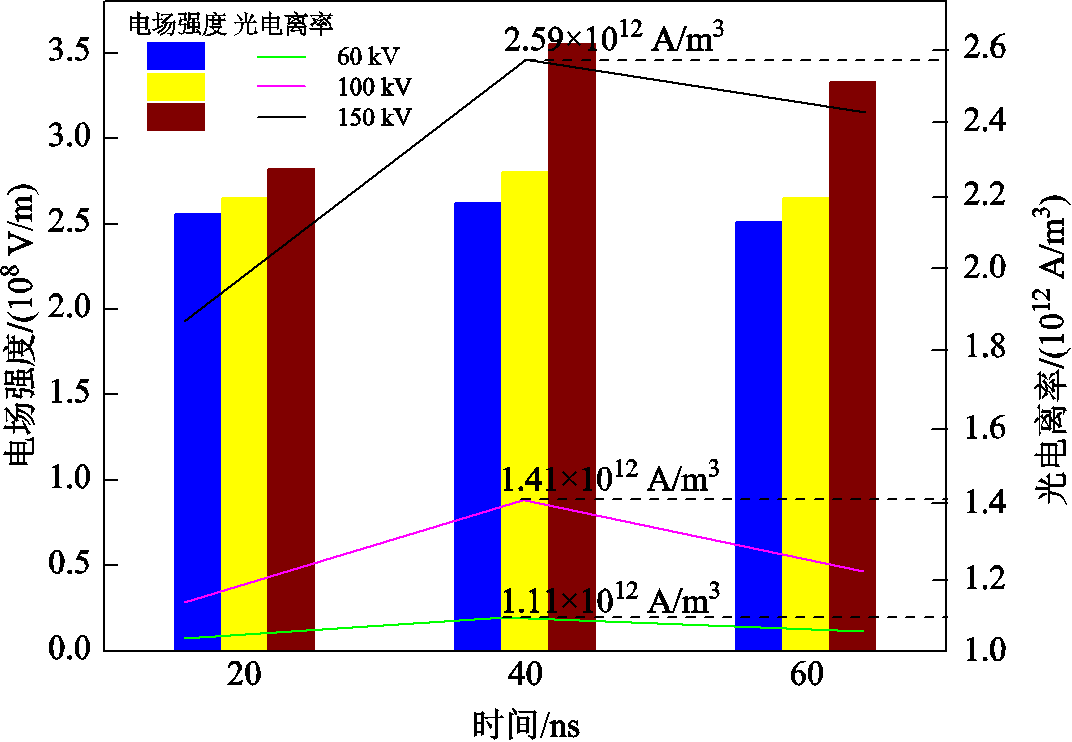
图10 不同时刻下的流注头部电场强度峰值及光电离率
Fig.10 Peak electric field and photoionization rate of the streamer head at different times
图11为100 kV冲击电压下z轴方向上的空间电荷密度分布,其中,空间电荷密度为正、负离子及电子密度的总和。35~75 ns时段内,液相区域流注头部的空间电荷密度随着时间的增加而增加,其峰值从547 nC/mm3增加到1 212 nC/mm3。此外,随着时间的增加,针尖处出现了新的空间电荷密度峰值。由图5可知,随着温度的升高,针尖附近产生了气相区域,在碰撞电离持续作用下,针尖区域产生更多的空间电荷。在电场的作用下,这些电荷在针尖处引发了更多的扰动,这可能是针尖处产生更多密集小流注分支的原因。
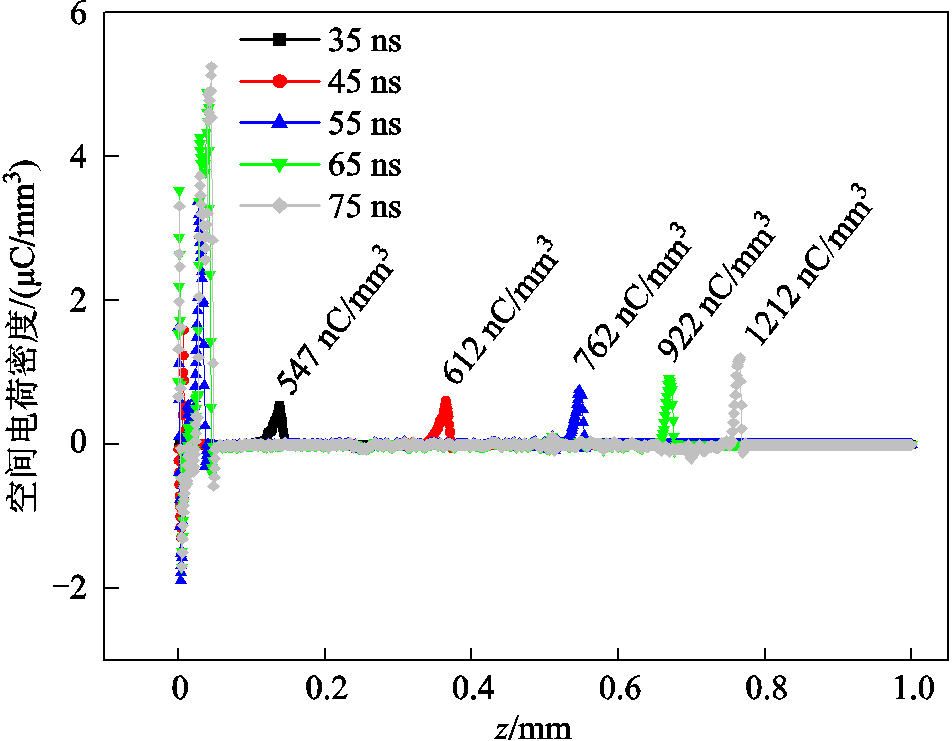
图11 空间电荷密度分布
Fig.11 Space charge density distribution
图12为100 kV冲击电压下50 ns时电子、正负离子和空间电荷的密度分布。正离子的分布与空间电荷的分布相似。由于液相和气相中的流注头部均为电离反应最为剧烈的位置,因此正离子和电子主要分布在流注头部。负离子是由电子和中性分子发生吸附而产生,且稳定性较差,结合后会迅速分解为中性分子和电子,因此负离子的密度峰值较低。
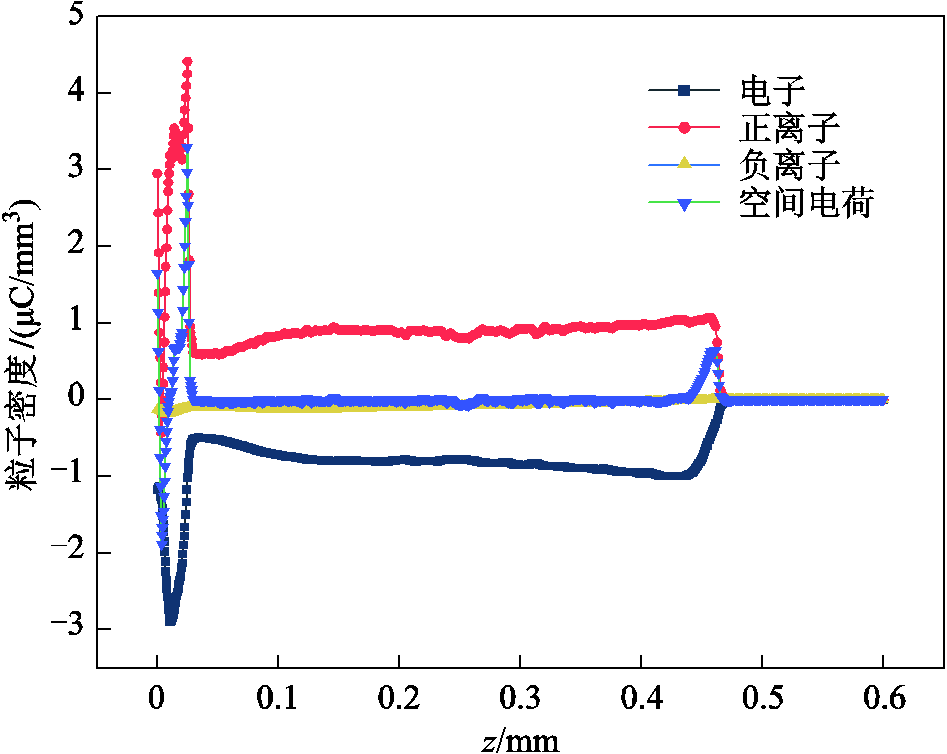
图12 50 ns时刻下三种带电粒子密度分布
Fig.12 Density distribution of three charged particles at 50 ns
本文基于电流体动力学模型,建立了以相变温度为临界点的气相碰撞电离项,以及与电场阈值相关的光电离项的酯基绝缘油流注放电模型,模拟了酯基绝缘油流注放电过程,探究了流注形态特征、流注通道温度分布、传播特性和空间电荷分布规律,得到以下结论:
1)光电离产生的大量载流子会导致局部电场发生畸变,促进了优势流注分支的产生,而针尖处密集的小流注分支则是由气相区域发生碰撞电离造成的,改进模型在流注形态上更符合试验观察到的流注多分支特点。相变对主流注的传播速度几乎无影响,这主要是由于主流注的发展是由光电离和场致电离所控制。
2)流注速度变化趋势与试验结果相似,呈现先增加后减小的变化趋势。光电离项的引入使模型产生更多的载流子,促进了流注的传播,因此在三种不同电压下原始模型的主流注传播速度均低于改进模型,且在较高电压下改进模型的主流注传播速度率先实现了从第二模式(慢速)到第三模式(快速)的转换。因此,酯基绝缘油易产生快速流注可能是由于光电离导致的。
3)模拟结果显示,高温区域主要集中在针尖处,随着温度的升高而引起相变,此时碰撞电离在气相区域内产生更多的空间电荷。在电场的作用下,这些电荷在针尖处引发了更多的扰动,这可能是导致针尖区域形成更多密集小流注分支的原因。
本文研究有助于改进和完善酯基绝缘油流注放电模型,为酯基绝缘油快速流注的产生机理的研究提供了新思路,在一定程度上可为提升酯基绝缘油的击穿电压提供理论指导。同时也表明在未来酯基绝缘油流注放电的研究工作当中,应需关注相变和光电离等因素影响,这对放电模型的建立和放电机理的完善具有重要意义。
参考文献
[1] 张宁, 刘士利, 郝建, 等. 变压器油中气泡杂质相局部放电特性研究综述[J]. 电工技术学报, 2023, 38(10): 2757-2776.
Zhang Ning, Liu Shili, Hao Jian, et al. Review on partial discharge characteristics of bubble impurity phase in transformer oil[J]. Transactions of China Electrotechnical Society, 2023, 38(10): 2757-2776.
[2] Shen Zijia, Wang Feipeng, Wang Zhiqing, et al. A critical review of plant-based insulating fluids for transformer: 30-year development[J]. Renewable and Sustainable Energy Reviews, 2021, 141: 110783.
[3] 谢一鸣, 金硕, 阮江军, 等. 变压器油浸纸电气参数分区反演优化算法[J]. 高压电器, 2023, 59(8): 1-11.
Xie Yiming, Jin Shuo, Ruan Jiangjun, et al. Multi-regional inverse optimization algorithm for electrical parameters of oil-immersed paper of transformer[J]. High Voltage Apparatus, 2023, 59(8): 1-11.
[4] 刘道生, 周春华, 丁金, 等. 变压器纳米改性油纸复合绝缘研究综述[J]. 电工技术学报, 2023, 38(9): 2464-2479, 2490.
Liu Daosheng, Zhou Chunhua, Ding Jin, et al. Research overview of oil-paper composite insulation modified by nano particles for transformer[J]. Transactions of China Electrotechnical Society, 2023, 38(9): 2464-2479, 2490.
[5] 郑玉平, 郝治国, 薛众鑫, 等. 大型电力变压器安全运行与主动保护技术探索[J]. 电力系统自动化, 2023, 47(20): 1-12.
Zheng Yuping, Hao Zhiguo, Xue Zhongxin, et al. Exploration of safe operation and active protection technology for large-capacity power transformers[J]. Automation of Electric Power Systems, 2023, 47(20): 1-12.
[6] 廖瑞金, 张爽, 杨丽君, 等. 天然酯-纸绝缘与矿物油-纸绝缘的热老化及工频击穿特性对比[J]. 高电压技术, 2012, 38(4): 769-775.
Liao Ruijin, Zhang Shuang, Yang Lijun, et al. Comparative analyses of thermal aging and power frequency breakdown characteristics between natural ester-paper insulation and mineral oil-paper insulation[J]. High Voltage Engineering, 2012, 38(4): 769-775.
[7] 赵洪山, 常杰英, 曲岳晗, 等. 基于二元非线性Wiener随机过程的变压器油纸绝缘剩余寿命预测方法[J]. 电工技术学报, 2023, 38(15): 4040-4049.
Zhao Hongshan, Chang Jieying, Qu Yuehan, et al. Residual life prediction method of transformer oil-paper insulation based on binary nonlinear Wiener random process[J]. Transactions of China Electrotechnical Society, 2023, 38(15): 4040-4049.
[8] 梁苏宁, 李剑, 王飞鹏, 等. 正极性雷电冲击电压下天然酯绝缘油油纸沿面流注动态变化规律研究[J]. 中国电机工程学报, 2021, 41(1): 156-165.
Liang Suning, Li Jian, Wang Feipeng, et al. Study on the dynamic characteristics of streamer along the interface surface of natural ester insulating oil-pressboard system under positive lightning impulse voltage[J]. Proceedings of the CSEE, 2021, 41(1): 156-165.
[9] 但林阳, 黄正勇, 王飞鹏, 等. 植物绝缘油抑制离子迁移的动力学机制研究[J]. 中国电机工程学报, 2023, 43(11): 4474-4485.
Dan Linyang, Huang Zhengyong, Wang Feipeng, et al. Study on the dynamic mechanism of inhibited ion mobility in vegetable insulating oil[J]. Proceedings of the CSEE, 2023, 43(11): 4474-4485.
[10] 崔鲁, 陈伟根, 张知先, 等. 植物油浸绝缘纸的热稳定性及其对气隙放电发展的影响[J]. 中国电机工程学报, 2018, 38(4): 1248-1254, 1302.
Cui Lu, Chen Weigen, Zhang Zhixian, et al. Thermal stability of vegetable oil impregnated pressboard and its influence on the air-gap discharge development[J]. Proceedings of the CSEE, 2018, 38(4): 1248-1254, 1302.
[11] 陈鑫, 郝建, 冯大伟, 等. 三元混合式绝缘油和矿物油的雷电冲击击穿及产气特性对比分析研究[J]. 电工技术学报, 2020, 35(4): 906-918.
Chen Xin, Hao Jian, Feng Dawei, et al. Comparative study on lightning impulse breakdown and gas production characteristics of three-element mixed insulation oil and mineral oil[J]. Transactions of China Electrotechnical Society, 2020, 35(4): 906-918.
[12] Villarroel R, Garcia D F, Garcia B, et al. Moisture diffusion coefficients of transformer pressboard insulation impregnated with natural esters[J]. IEEE Transactions on Dielectrics and Electrical Insulation, 2015, 22(1): 581-589.
[13] Vasconcellos V, Sbravati A, Cera Zanetta L, et al. Increased loadability of transformers using natural ester and cellulosic materials as high temperature insulation systems[J]. IEEE Electrical Insulation Magazine, 2018, 34(5): 8-17.
[14] Lesaint O. Prebreakdown phenomena in liquids: propagation ‘modes’ and basic physical properties[J]. Journal of Physics D: Applied Physics, 2016, 49(14): 144001.
[15] Reffas A, Moulai H, Beroual A. Comparison of dielectric properties of olive oil, mineral oil, and other natural and synthetic ester liquids under AC and lightning impulse stresses[J]. IEEE Transactions on Dielectrics and Electrical Insulation, 2018, 25(5): 1822-1830.
[16] Hwang J G, Zahn M, Pettersson L A A. Mechanisms behind positive streamers and their distinct propagation modes in transformer oil[J]. IEEE Transactions on Dielectrics and Electrical Insulation, 2012, 19(1): 162-174.
[17] Hwang J G. Elucidating the mechanisms behind pre-breakdown phenomena in transformer oil systems[D]. Cambridge: Massachusetts Institute of Technology, 2010.
[18] 李元, 穆海宝, 邓军波, 等. 正极性纳秒脉冲电压下变压器油中流注放电仿真研究[J]. 物理学报, 2013, 62(12): 334-344.
Li Yuan, Mu Haibao, Deng Junbo, et al. Simulational study on streamer discharge in transformer oil under positive nanosecond pulse voltage[J]. Acta Physica Sinica, 2013, 62(12): 334-344.
[19] Wang Zheming, Xu Hongyun, Zhou You, et al. Numerical modeling of positive streamer propagation in alternative natural ester and traditional naphthenic oil under sub-microsecond pulsed voltages[J]. Journal of Physics D Applied Physics, 2023, 56(34): 344004.
[20] 施健, 司马文霞, 杨庆, 等. 纳米粒子对变压器油中流注发展过程影响的仿真分析[J]. 高电压技术, 2015, 41(2): 424-431.
Shi Jian, Sima Wenxia, Yang Qing, et al. Simulation analysis of the effect of nanoparticles on streamer development in transformer oil[J]. High Voltage Engineering, 2015, 41(2): 424-431.
[21] Wang Feng, Liang Kaibin, Zhong Lipeng, et al. Effect of metal ions and suspended particles on streamer propagation[J]. IEEE Transactions on Dielectrics and Electrical Insulation, 2023, 30(3): 1154-1161.
[22] 李显东, 何桦, 肖天飞, 等. 液相扰动对水中预击穿过程的影响[J]. 中国电机工程学报, 2022, 42(10): 3846-3853.
Li Xiandong, He Hua, Xiao Tianfei, et al. Influence of liquid phase disturbance on underwater pre-breakdown process[J]. Proceedings of the CSEE, 2022, 42(10): 3846-3853.
[23] 李显东, 刘毅, 周古月, 等. 针–板电极下水中亚音速流注形态与发展过程[J]. 中国电机工程学报, 2018, 38(5): 1562-1571.
Li Xiandong, Liu Yi, Zhou Guyue, et al. Morphology and development of underwater subsonic streamer under needle to plane electrodes[J]. Proceedings of the CSEE, 2018, 38(5): 1562-1571.
[24] Sun Anbang, Huo Chao, Zhuang Jie. Formation mechanism of streamer discharges in liquids: a review[J]. High Voltage, 2016, 1(2): 74-80.
[25] Liang Suning, Wang Feipeng, Huang Zhengyong, et al. Significantly improved electrical breakdown strength of natural ester liquid dielectrics by doping ultraviolet absorbing molecules[J]. IEEE Access, 2019, 7: 73448-73454.
[26] 李向荣, 王飞鹏, 黄正勇, 等. 光电离对天然酯绝缘油流注放电影响规律[J]. 电工技术学报, 2023, 38(12): 3350-3365.
Li Xiangrong, Wang Feipeng, Huang Zhengyong, et al. Impact of photoionization on streamer discharge in natural ester insulating oil[J]. Transactions of China Electrotechnical Society, 2023, 38(12): 3350-3365.
[27] Madshaven I, Hestad O L, Unge M, et al. Photoionization model for streamer propagation mode change in simulation model for streamers in dielectric liquids[J]. Plasma Research Express, 2020, 2(1): 015002.
[28] Wang Kaizheng, Wang Feipeng, Li Jian, et al. Synthesis of trimethylolpropane fatty acid triester as a high performance electrical insulating oil[J]. Industrial Crops and Products, 2019, 142: 111834.
[29] Lesaint O, Gournay P. On the gaseous nature of positive filamentary streamers in hydrocarbon liquids. I: Influence of the hydrostatic pressure on the propagation[J]. Journal of Physics D: Applied Physics, 1994, 27(10): 2111-2116.
[30] Gournay P, Lesaint O. On the gaseous nature of positive filamentary streamers in hydrocarbon liquids. II: propagation, growth and collapse of gaseous filaments in pentane[J]. Journal of Physics D Applied Physics, 1994, 27(10): 2117-2127.
[31] 安大炜. 针-板电晕放电特性及空间电荷迁移规律研究[D]. 重庆: 重庆大学, 2017.
An Dawei. Study on needle-plate corona discharge and migration characteristics of ion space charge[D]. Chongqing: Chongqing University.
[32] O'Sullivan F M. A model for the initiation and propagation of electrical streamers in transformer oil and transformer oil based nanofluids[D]. Cambridge: Massachusetts Institute of Technology, 2007.
[33] Devins J C, Rzad S J, Schwabe R J. Breakdown and prebreakdown phenomena in liquids[J]. Journal of Applied Physics, 1981, 52(7): 4531-4545.
[34] 陈刚, 李剑, 黄正勇, 等. 考虑载流子密度扰动的植物绝缘油中初始流注放电仿真[J]. 中国电机工程学报, 2021, 41(3): 1176-1184.
Chen Gang, Li Jian, Huang Zhengyong, et al. Simulation of streamer discharge considering carrier density fluctuation in vegetable insulating oil[J]. Proceedings of the CSEE, 2021, 41(3): 1176-1184.
[35] 郑含博, 杨杭, 凤永吉, 等. 雷电冲击下天然酯的长间隙击穿特性仿真研究[J]. 电工技术学报, 2023, 38(23): 6451-6460.
Zheng Hanbo, Yang Hang, Feng Yongji, et al. Simulation study on long gap breakdown characteristics of natural esters under lightning impulse[J]. Transactions of China Electrotechnical Society, 2023, 38(23): 6451-6460.
[36] Qian J, Joshi R P, Schamiloglu E, et al. Analysis of polarity effects in the electrical breakdown of liquids[J]. Journal of Physics D: Applied Physics, 2006, 39(2): 359-369.
[37] Sun Anbang, Teunissen J, Ebert U. 3-D particle modeling of positive streamer inception from a needle electrode in supercritical nitrogen[J]. IEEE Transactions on Plasma Science, 2014, 42(10): 2416-2417.
[38] 蒋兴良, 吴建国, 任晓东, 等. 大气压下湿度对气隙流注放电及击穿的影响[J]. 高电压技术, 2023, 49(4): 1743-1752.
Jiang Xingliang, Wu Jianguo, Ren Xiaodong, et al. Influence of humidity on air gap streamer discharge and breakdown under atmospheric pressure[J]. High Voltage Engineering, 2023, 49(4): 1743-1752.
[39] Meek J M, Craggs J D. Electrical Breakdown of Gases[M]. New York: John Wiley & Sons, 1978.
[40] Davari N, Åstrand P O, Van Voorhis T. Field-dependent ionisation potential by constrained density functional theory[J]. Molecular Physics, 2013, 111(9/10/11): 1456-1461.
[41] 王亚超. 基于密度泛函理论的甘油三酯分子及植物绝缘油放电相关参量研究[D]. 重庆: 重庆大学, 2018.
Wang Yachao. Study on the discharge-related parameters of triglyceride molecules and vegetable insulating oils based on density functional theory[D]. Chongqing: Chongqing University, 2018.
[42] Li Xiangrong, Wang Feipeng, Wang Kaizheng, et al. Numerical evaluation on the propagation of non-breakdown streamer in natural ester under negative lightning impulse voltage via shadowgraph imaging[J]. IEEE Transactions on Dielectrics and Electrical Insulation, 2021, 28(4): 1198-1206.
[43] Hallac A, Georghiou G E, Metaxas A C. Secondary emission effects on streamer branching in transient non-uniform short-gap discharges[J]. Journal of Physics D: Applied Physics, 2003, 36(20): 2498-2509.
[44] Qureshi M I, Beroual A, Al-Ammar E A. Optical observation of streamer propagation and breakdown in seed based insulating oil under impulse voltages[J]. International Journal of Physical Sciences, 2014, 9(13): 292-301.
[45] 王琪, 王萌, 王珏, 等. 纳秒脉冲下变压器油两相流注放电仿真研究[J]. 强激光与粒子束, 2020, 32(2): 63-67.
Wang Qi, Wang Meng, Wang Jue, et al. Two-phase streamer characteristics in transformer oil under nanosecond impulses voltages[J]. High Power Laser and Particle Beams, 2020, 32(2): 63-67.
[46] 王开正. 抗老化中链脂肪酸三酯绝缘油的击穿及流注放电研究[D]. 重庆: 重庆大学, 2020.
Wang Kaizheng. Investigation on breakdown and streamer discharge of anti-aging medium-chain fatty acid triester insulating oil[D]. Chongqing: Chongqing University, 2020.
[47] Li Shi, Wang Feipeng, Wang Qiang, et al. Numerical modeling of branching-streamer propagation in ester-based insulating oil under positive lightning impulse voltage: effects from needle curvature radius[J]. IEEE Transactions on Dielectrics and Electrical Insulation, 2023, 30(1): 139-147.
[48] Liu Qiang, Wang Zhogndong. Streamer characteristic and breakdown in synthetic and natural ester transformer liquids under standard lightning impulse voltage[J]. IEEE Transactions on Dielectrics and Electrical Insulation, 2011, 18(1): 285-294.
[49] Hizal E M, Di̇nçer S. Breakdown time lags and prebreakdown phenomena in transformer oil, effects of hydrostatic pressure[J]. Journal of Electrostatics, 1982, 12: 333-343.
[50] Linhjell D, Lundgaard L E, Unge M. Pressure dependent propagation of positive streamers in a long point-plane gap in transformer oil[C]//2019 IEEE 20th International Conference on Dielectric Liquids (ICDL), Roma, Italy, 2019: 1-3.
[51] Linhjell D, Lundgaard L E, Unge M, et al. Pressure-dependent propagation of streamers under step voltage in a long point-plane gap in transformer oil[J]. IEEE Transactions on Dielectrics and Electrical Insulation, 2020, 27(5): 1595-1603.
[52] Shen Shuhang, Liu Qiang, Wang Zhongdong. Shockwave characteristics of streamer propagation in insulating liquids under positive lightning impulse[J]. IEEE Transactions on Dielectrics and Electrical Insulation, 2021, 28(2): 493-501.
Abstract In recent years, biodegradable and environmentally friendly synthetic ester insulation oils with high ignition points have received attention and extensive research, and have been applied to in-service power transformers. However, in long oil gaps, synthetic ester insulation oil is more prone to rapid streamer compared to mineral insulation oil, and rapid streamer has been proven to be one of the most critical factors leading to insulation faults in oil-immersed transformers, which limits its application in transformers at higher voltage levels. At present, research on the dielectric properties of synthetic ester insulating oils mainly focuses on experimental observation, making it difficult to observe their microscopic processes under high electric fields. In this study, based on the electrohydrodynamic model, a gas phase impact ionization term with phase transition temperature as the critical point and an ester based insulating oil streamer discharge model considering molecular ionization energy, temperature, and electric field photoionization terms were established. The streamer discharge process of ester based insulating oil was simulated, and the streamer morphology characteristics, streamer channel temperature distribution, propagation characteristics, and space charge distribution were investigated.
Firstly, the mechanism of the generation and capture of positive ions, electrons, and negative ions was explained using the convection diffusion equation. By coupling the Poisson equation with the convection diffusion equation, the process of charge movement and spatial charge distribution in synthetic ester insulating oil under the action of an electric field can be described. Secondly, collision ionization was established using the phase transition temperature of synthetic ester insulating oil as the critical point. Thirdly, a photoionization model was established that considers the correlation between molecular ionization energy, temperature, and electric field. Finally, all oil parameters are derived from the previously prepared synthetic ester insulation oil, trimethylolpropane triate (TME).
The results indicate that the large number of carriers generated by the photoionization term can cause local electric field distortion and promote the generation of dominant streamer branches, while the denser small streamer branches at the needle tip are caused by impact ionization in the gas phase region. The improved model is more in line with the observed multi branch characteristics of the streamer in terms of streamer morphology. The phase transition has almost no effect on the propagation speed of the main streamer, mainly because the development of the main streamer is controlled by photoionization and field ionization. The trend of streamer velocity change is similar to the experimental results, showing a trend of increasing first and then decreasing. The introduction of the photoionization term causes the model to generate more carriers, promoting the propagation of the main streamer. Therefore, the propagation speed of the main streamer in the original model is slower than that of the improved model under three different voltages. Moreover, at higher voltages, the main streamer propagation speed of the improved model is the first to achieve the transition from 2nd to 3rd propagation mode. Therefore, the reason for the rapid streamer of ester based insulating oils may be due to photoionization. The simulation results show that the high-temperature region is mainly concentrated at the needle tip, causing a phase transition as the temperature increases. At this time, impact ionization generates more space charges in the gas phase region. Under the action of electric field, these charges cause more disturbances at the needle tip, which may be the reason for the formation of more dense small streamer branches in the needle tip region.
keywords:Ester based insulating oil, photoionization, gas phase, streamer discharge
中图分类号:TM214
DOI: 10.19595/j.cnki.1000-6753.tces.231528
国家自然科学基金青年项目(52107017)、云南省科技厅基础研究专项青年项目(202201AU070172)、国家自然科学基金面上项目(52177016)和国家自然科学基金重点项目(52130707)资助。
收稿日期 2023-09-18
改稿日期 2023-10-30
王开正 男,1988年生,副教授,硕士生导师,研究方向为电绝缘老化及电工绝缘材料。E-mail:wkz@kust.edu.cn
李露露 女,1989年生,副教授,硕士生导师,研究方向为电力扰动分析与电力电缆。E-mail:lilulu1203@foxmail.com(通信作者)
(编辑 李 冰)